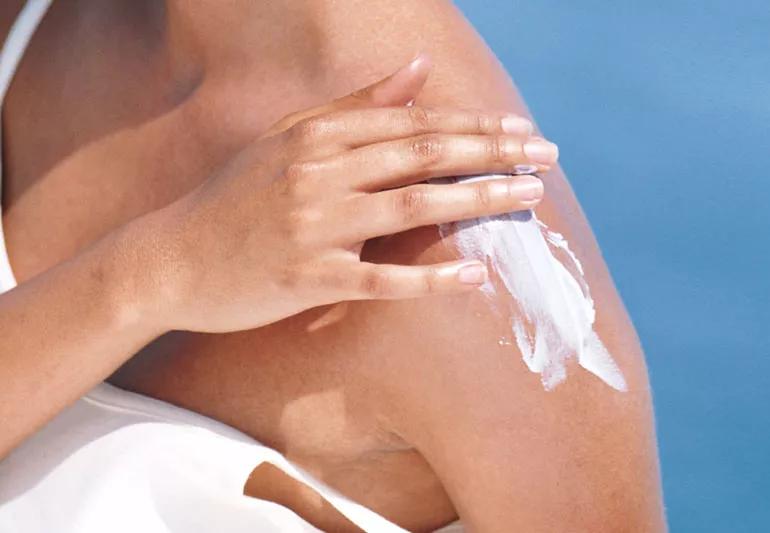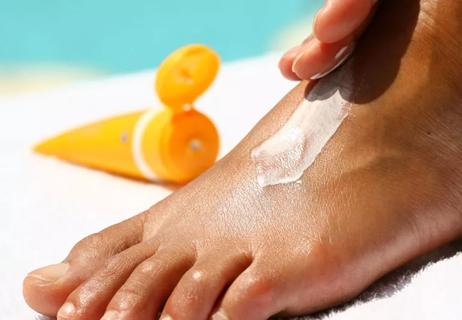Advertisement
An expert weighs in on sunscreen ingredients, application tips and more

Whether your skin care routine is simple or elaborate, there’s one product you should never skip: sunscreen. But with thousands of sunscreens on the market today, how do you choose the right one?
Advertisement
Cleveland Clinic is a non-profit academic medical center. Advertising on our site helps support our mission. We do not endorse non-Cleveland Clinic products or services. Policy
Dermatologist Melissa Piliang, MD, provides advice on choosing a sunscreen that works — and how to avoid ones that don’t.
Sunscreen uses active ingredients to filter ultraviolet (UV) rays before they reach your skin. UV rays — which come from the sun and tanning beds — can cause skin cancer and extra signs of aging.
Sunscreen comes in gels, creams, powders and sprays that you apply directly to your skin. People who use sunscreen regularly have:
The U.S. Food and Drug Administration (FDA) regulates sunscreens to ensure they’re safe and effective. “All FDA-approved sunscreens contain approved physical or chemical blockers or a mix of the two,” says Dr. Piliang.
Check the active ingredients on your sunscreen label to find out whether your sunscreen contains physical or chemical filters.
Advertisement
Physical sunscreen ingredients — sometimes called mineral sunscreens — include:
If your sunscreen contains chemical filters, the active ingredients may include:
Physical sunscreen ingredients work like a reflective barrier, scattering UV rays before they penetrate your skin. Chemical sunscreens are partially absorbed into the skin and create a chemical reaction that helps prevent UV damage.
There are more than 10 types of chemical sunscreen ingredients currently on the market. While these ingredients were previously approved by the FDA, a recent announcement calls for new testing to determine how safe these chemical ingredients really are.
Dr. Piliang explains some of these concerns surrounding chemical sunscreen ingredients.
In 2019, the FDA stated that the two main physical sunscreen ingredients — titanium dioxide and zinc oxide — are safe and effective for use in sunscreens. At the same time, they also deemed two ingredients as neither safe nor effective. These two ingredients to avoid are:
The FDA also called into question the safety and effectiveness of the majority of chemical sunscreen ingredients. It proposed that more research should be done on the following chemical sunscreen ingredients:
An additional concern is in regard to possible ingredient contaminations. A recent review of products found that many aerosol sunscreens (and other personal care products) include benzene — a highly flammable chemical that can cause serious health concerns after long-term exposure. Just last year, Johnson & Johnson recalled five types of Neutrogena® and Aveeno® spray sunscreens because of high levels of benzene detected. While the ingredient wasn’t listed on the products, the recall found that there was a contamination that caused benzene to form.
Due to this finding, the FDA has required other companies and manufacturers to test their aerosol products to make sure that benzene — and the formation of it — isn’t present. This has led to 25 million products from more than a dozen other brands being recalled.
If you want to be cautious, choose a sunscreen that contains zinc oxide or titanium dioxide, which both have the GRASE (FDA “generally accepted as safe and effective”) designation, says Dr. Piliang.
Sunscreen has a sun protection factor (SPF) number on the label. This number is important, but it’s not the only thing to look for.
Advertisement
“Your skin is exposed to two types of UV rays: UVA and UVB,” explains Dr. Piliang. “The SPF number tells you how much protection the sunscreen provides against UVB rays, which are the main cause of sunburn. But SPF doesn’t tell you how much protection you’re getting from UVA rays, which can cause skin damage and skin cancer.”
To ensure you’re protected from UVA rays, choose a sunscreen that lists “broad spectrum” on the label. This term means the product protects against UVA and UVB rays.
When you apply sunscreen, be generous. A skimpy application could cheat you out of the protection you need. “Most adults need at least one ounce of sunscreen, or about the size of a shot glass, to get enough protection on their face, neck, arms and legs,” instructs Dr. Piliang. “Use about a nickel-sized dollop for just your face.”
Even if you slather on a large amount of sunscreen, it eventually breaks down and rubs off. The key is to apply early and often for the best protection.
“The active ingredients in sunscreen need about 30 minutes to kick in, so give it time to work before going out,” says Dr. Piliang. “Reapply at least every two hours. And even if your sunscreen says it’s waterproof, always reapply after swimming and toweling off.”
Advertisement
Should you always choose a high SPF? It depends on what you’re doing that day.
“For days when you’re outside for only short periods, you can get away with a minimum of SPF 15,” says Dr. Piliang. “But if you’re going to be outside for more than a few minutes, choose at least SPF 30.”
Remember to check the expiration date on your sunscreen, too. A bottle that has spent multiple summers baking in the sun doesn’t offer the same protection it once did.
Sunscreen should be a part of your routine anytime you go outside. But the sun’s rays are powerful, so don’t expect your sunscreen to do all the heavy lifting.
“No sunscreen can block all UV rays,” says Dr. Piliang. “Good sun protection should also include seeking shade, wearing a wide-brimmed hat and sunglasses and choosing clothing that has sun protection built in. Enjoy the sun — but be smart about how much exposure you’re getting.”
Advertisement
Learn more about our editorial process.
Advertisement

Babies shouldn’t wear sunscreen before 6 months old, so opt for shade and cooler parts of the day for outdoor fun time

Mineral sunscreens have a heavier texture to create a physical barrier, while chemical sunscreens are lighter and use a chemical reaction to prevent UV damage

Even on cloudy days or simply running errands, sunscreen is a must

Having darker skin tones doesn’t automatically offer protection from the sun

It’s easy to forget your ears, eyelids, lips and feet — but any exposed skin needs protection

More than just fashionable, the lenses reflect or block harmful UV rays and can reduce glare

Choose lotion-based options that contain titanium dioxide or zinc oxide

SPF makeup offers some protection, but you’re better off pairing it with sunscreen

If you’re feeling short of breath, sleep can be tough — propping yourself up or sleeping on your side may help

If you fear the unknown or find yourself needing reassurance often, you may identify with this attachment style

If you’re looking to boost your gut health, it’s better to get fiber from whole foods